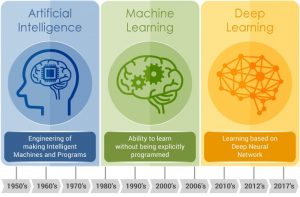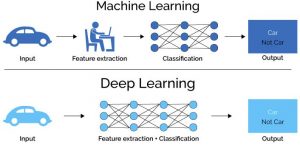Deep Learning vs Machine Learning

Deep learning and machine learning tend to most people to be synonymous buzzwords in the AI environment. This, though, is not the case. As a result, anyone interested in learning more about artificial intelligence can start by learning the words and distinguishing them. The good news is that it is not as complicated as specific stories on the subject lead people to believe.
Artificial intelligence is classified into two types: machine learning and deep learning. Deep learning is a branch of machine learning, as we describe in our previous post on Deep Learning. Both machine learning and deep learning begin with training and test data and a model, which are then optimized to determine the weights that best match the dataset. Both can manage numeric (regression) and non-numeric (classification) challenges, but deep learning models tend to provide better fits than machine learning models in many different applications, such as object recognition and language translation. The distinction between them is in how each algorithm learns. Dargan and his friends stated this distinction as “Machine Learning starts with observations such as the direct experiences to prepare for the features and patterns in data and producing better results and decisions in the future. Deep learning relies on the collection of machine learning algorithms which models high-level abstractions in the data with multiple nonlinear transformations.”

Traditional machine learning, also known as “non-deep” machine learning, relies on human interaction to recognize and includes named databases to learn the variations between data inputs. If I had to display you a series of images of various forms of fast food, for example, I would mark each picture with a fast-food category, such as “pizza,” “burger,” or “taco.” The supervised learning machine learning model will practice and learn based on the labeled data fed into it.
Deep machine learning can use named data to instruct the algorithm, but it does not have to; it can even teach itself using unsupervised learning. Unsupervised learning uses unstructured or unlabeled data, whereas supervised learning uses classified data.
A machine learning algorithm can group and identify inputs by observing patterns in the results. Using the same analogy as before, we may classify photographs of pizzas, burgers, and tacos into their respective groups based on image similarities. Given the underlying data structure, a deep learning model would need more data points to increase accuracy. In contrast, a machine learning model would need fewer data. Deep learning is mainly used in more complex applications such as virtual assistants and fraud detection.
When to use deep learning?
When you work with an organization that has many data to analyze.
If you need to solve problems that are too difficult for machine learning to solve.
If you have a lot of computing power and can afford to spend much money on hardware and tools for deep learning network training.
When to use Machine learning?
If you have structured data that can be used to train machine learning algorithms.
If you want to use AI’s perks to get a leg up on the market, this is the place to be.
The best machine learning technologies will aid in the automation of a range of business processes, such as identity verification, advertisement, marketing, and data processing, and help leverage significant potential opportunities.
Source
Education, I. C. (2020, May 1). Deep Learning. IBM. https://www.ibm.com/cloud/learn/deep-learning
Dargan, S., Kumar, M., Ayyagari, M. R., & Kumar, G. (2019). A Survey of Deep Learning and Its Applications: A New Paradigm to Machine Learning. Archives of Computational Methods in Engineering, 27(4), 1071–1092. https://doi.org/10.1007/s11831-019-09344-w
